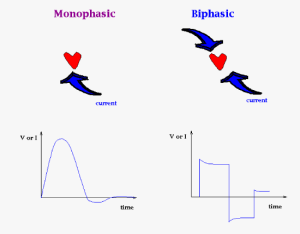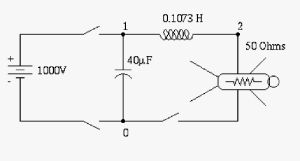4.4 – Defibrillators
WLO 5: Introduce concepts related to defibrillators
Defibrillation is an essential part of resuscitation. Survival chances of a fibrillating victim (ventricular fibrillation or ventricular tachycardia) start at 90% if defibrillated immediately and decrease by 10% every minute. Lack of blood circulation for even a few minutes may lead to irreversible organ damage, including brain damage. Early intervention by bystanders, even those with no training, can therefore buy time until professional help arrives, improving the chance of a successful outcome. Should a victim be in cardiac arrest and require defibrillation, it is crucial that Emergency Medical Services are called immediately. Defibrillators can also be used for monitoring and recording purposes; a different set of electrodes is available on some defibrillators for cardiac monitoring, though most defibrillators have the cardiac monitoring located within the pads.
An Automated External Defibrillator (AED or ‘defibrillator’) is a machine that is placed externally on the body and is used to give an electric shock when a person is in cardiac arrest i.e., when the heart suddenly stops pumping blood around the body. Modern defibrillators are simple and safe to operate and use. Once attached, the defibrillator will automatically analyze the individual’s heart rhythm and, if required, apply a shock to restart it or advise that CPR should be continued.
Defibrillators are often quite graphically pictured in films and television shows. Actually, defibrillation might induce some contractions in the muscles of the patient, but in no case will the patient jump. In most television shows, the paddles are used which may make a rescuer feel apprehensive about defibrillating a patient if they believe that they have to gel the paddles then rub them together before shocking the patient. All AEDs used in the public access setting have two pre-gelled patches that are easily placed onto the patient’s skin. This keeps the rescuer at a further distance from the patient during the shocking and enables the patches to stay on continuously during the resuscitation efforts.
Basic Types of Defibrillators
Defibrillators come in many different shapes and sizes.
Video
There are many different types of current defibrillators including:
- Manual Defibrillator
- Automated External Defibrillator (AED)
- Implantable Cardioverter Defibrillator (ICD)
- Wearable Cardioverter Defibrillator (WCD)
![]() To learn how to access the transcript for this video, see “YouTube transcript instructions (opens a new window)”
To learn how to access the transcript for this video, see “YouTube transcript instructions (opens a new window)”
Monophasic vs. Biphasic Defibrillation1
Defibrillators are an important medical device that resuscitates a stopped heart (in certain conditions). Scientists and engineers worked on various versions of the defibrillator in the early 1900s but the origins of the device we use today comes from an electrical engineering in the 1930s. The device works by sending electric shocks to the heart, but why this works is still a matter of research. Today there are two types of defibrillators in use: a monophasic and a biphasic defibrillator. The biphasic is considered to be more advanced but the monophasic is still used in situations where it is difficult to use the biphasic. Figure 4.4.1 demonstrates the different waveforms of monophasic and biphasic pulses.

A monophasic defibrillator just sends current one way through the paddles that are on different sides of the heart whereas the biphasic sends current both ways. A sketch of the wave forms are show above. As you can see, the monophasic waveform is similar to the Lown waveform shown above while the biphasic pulse is somewhat square wave form. The simple defibrillator can be modeled rather simply by an electrical circuit shown below in Figure 4.4.2.

As shown above in the simple circuit for a simple defibrillator, the battery charges the capacitor which then acts as the power source (a capacitor will discharge fast). The human is represented by a [latex]50Ω[/latex] resistor above.
Video
The following video describes the difference between mono and biphasic application of defibrillation.
![]() To learn how to access the transcript for this video, see “YouTube transcript instructions (opens a new window)”
To learn how to access the transcript for this video, see “YouTube transcript instructions (opens a new window)”
Maintaining your Defibrillator
Modern defibrillators undertake regular self-tests and, if a problem is detected, will indicate this by means of a warning sign or light on the machine. You should ensure that a procedure is in place for defibrillators to be checked for such a warning on a regular (and no less frequently than weekly) basis, possibly by a designated person, and have a method for recording when a check has taken place. If defibrillators are kept in an internal or external cabinet, schools should also regularly check the condition of the cabinet, including the door closure and any lock. You should consult the user manual of their defibrillator to ensure that you are aware of what to look for and what remedial action will need to be taken in the event of a fault. Any fault which occurs during the defibrillator’s warranty period and for which a solution
cannot be found in the manual should be reported to the manufacturer immediately.
Many defibrillators may require you to perform some additional monthly and/or annual checks to ensure that they are functioning correctly. Schools should consult the user manual for details. Failure to perform these checks could potentially mean that the defibrillator fails to function properly when needed. Defibrillators do not normally require regular servicing by a suitably qualified technician.
Pads, safety razors, protective gloves and pocket masks need to be replaced after every incident. Some manufacturers may also advise that the battery is replaced after an incident, whether or not the charge level on the battery indicator is showing as low; you should check the device user manual for details. Even when an incident has not taken place, batteries and pads have finite service lives, and should be replaced after the period of time specified by the manufacturer. This will usually be upon reaching the expiry date indicated on each consumable, or in the case of batteries, when the battery indicator shows that the battery is low – whichever is the sooner. Care should be taken to ensure that replacement consumables are the correct ones for the device. Consumables designed for different defibrillators are not usually compatible with one another.
Tables 4.4.1 and 4.4.2 are examples minimum general and power specifications for a defibrillator. Keep in mind that the minimum standards may change based on the country, province or institution where you may be working.
Table 4.4.1
Title is needed here. (example: Example General Specifications for a Defibrillator)
| Item no. | Description |
|---|---|
| 1 | The device must be easily transportable in its case with all accessories. |
| 2 | The device must have a water ingress protection(IP) rating of 4 or above (as defined in accordance with BS EN 60529:1992 or equivalent |
| 3 | The device must be able to be stored at 0 to 40 degrees C. |
| 4 | The device must be able to operate at 0 to 40 degrees C. |
| 5 | The device must be able to operate at non-condensing relative humidity levels of 10 to 95%. |
| 6 | The device must incorporate a real-time clock and/or the associated software must provide the ability for events to be time-stamped. |
| 7 | The device must have a life expectancy of at least 5 years. |
| 8 | Replaceable batteries and/or any other replaceable power sources for the device must have a shelf life of at least 3 years. |
| 9 | Replaceable batteries and/or any other replaceable power sources for the device must have a life expectancy of at least 2 years once inserted into the defibrillator. |
| 10 | The weight of the device including the battery, case and standard accessories must not exceed 4kg. |
Table 4.4.2
Title is needed here.
| Item no. | Description |
|---|---|
| 11 | The device must be able to operate on a battery-only basis. |
| 12 | The device must have a battery shock capacity minimum of 30 full discharges at the maximum energy the device operates at throughout the standard life of the battery. |
| 13 | The initial analysis time plus the time to charge and be ready to deliver initial shock must be a maximum of 15 seconds. |
Troubleshooting Defibrillators
Click the check mark icon to view comments for that step.
Example Test Question: Calculations
Question
A defibrillator has an available energy (WA) of 200 joules (J). If the thorax resistance is 40 ohms (W), the electrode—skin resistance of a paddle with sufficient electrode gel is 30 ohms and the internal resistance of the defibrillator is 10 ohms. Calculate the energy delivered to the thorax of the patient.
[latex]{WT} = \left(\dfrac{RT}{{RD} + {2RE} + {RT}}\right) \cdot {WD}[/latex]
Solution
In this case, RT = 40 ohms, RE =30 ohms, and RD = 10 ohms. The equation for the amount energy delivered yields:
[latex]{WT} = \left(\dfrac{RT}{RD + 2{RE} + RT}\right) \cdot {WD}[/latex]
[latex]{WT} = \left(\dfrac{40}{10 + (2 \cdot 30) + 40}\right) \cdot 200[/latex]
[latex]WT = 72.7 \text{ joules}[/latex]
Here is another question that can be applied to defibrillators: How much energy can be stored if 10 V is applied to a 10 F capacitor?
Use the equation: V = 1/2 cv2
Attributions
This chapter is partly adapted from the following:
- First Aid for Canada by WikiBooks is licensed under CC BY-SA 2.5
- Automated External Defibrillators (AEDs): Guidance for schools by the Department for Education is licensed under Open Government License v3.0
- EGR 1010: Introduction to Engineering for Engineers and Scientists by LibreTexts Engineering is licensed under CC BY-NC-SA 4.0
References
- Video: Defibrillators by Biomedical Engineers TV
- Video: Monophasic vs Biphasic EMS Monitors by EMTPrep
- Figure 4.5.4 Defibrialltor Troubleshooting and Repair by Engineering World Health., All Rights Reserved. Used with permission.

